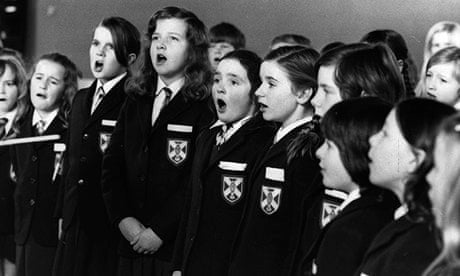When we think of children making music at school we think of violins being scraped or recorders tooted out of tune. Classroom Projects, however, reveals a very different world. This compilation of school recordings from 1959 to the late 1970s shows children experimenting with musique concrète, adapting old folk songs, writing their own compositions and showing what heights can be reached with the right tools and encouragement.
Classroom Projects' curator is Jonny Trunk of Trunk Records, who since 1995 has been releasing unusual music, such as lost film soundtracks or advert music. Making this particular collection has moved him though, he says. "I've realised children are like sponges when it comes to music. You can play them anything avant-garde or weird and they won't question it. They just absorb it and enjoy it."
Trunk has two children, who loved this record, but he also found it moving to listen to children's creativity being unleashed, all those years ago. Classroom Projects has an even deeper resonance at a time when music isn't high on the government's list of education priorities (the subject notoriously wasn't included in Michael Gove's Ebacc proposals last year).The first schools music Trunk found – in a Chelmsford charity shop – was 1970's Sound and Silence by John Paynter and Peter Aston. This LP had originally accompanied a book distributed through schools featuring two progressive composers encouraging children to play independently with sound: by trying to create the sound of a stormy day, for example, rather than learning music by rote.
The work of Paynter, a working-class Londoner who became professor of music at York University, and Aston, a composer chosen by Benjamin Britten to lead the University of East Anglia's music department, had a huge impact on music education. Their experiments later inspired music and movement classes and the late 80s GCSE music curriculum. It's fitting, then, that the tracks by these composers featured on Sound and Silence stand out. Musique Concrète features children making extraordinary sounds by playing with tape, while Music for Cymbals explores the many sounds and sensations percussion can produce.
Trunk tried and failed to track down many performers on this record – it didn't help that many of the schools no longer exist – but he did find Shirley Salzedo, now 51. A pupil of Northwood school in Middlesex, she was recorded at 15 playing a Scarlatti sonata. "I can still see myself sitting there at the school piano, everything being miked up," she remembers. "It was so exciting and such an unusual thing to do."

The resulting album, The Northwood Sound, was sold through the school, and it's important to note, Salzedo adds, that it was a comprehensive. Here, teachers encouraged pupils of all backgrounds and abilities, and Salzedo's own experience inspired her for life. Now a piano teacher, she makes educational music for children. "It's always stayed with me how children can really respond to sound, especially if teachers have the enthusiasm that mine did."
Today, enthusiasm for school records also extends to collectors. One record featured on Classroom Projects – Folk Group by Chelmsford County high school – sold recently on eBay for £227. There's even a website dedicated to finding them, somewherethereismusic.com. "It's partly because these records are privately pressed, handmade and homemade, and collectors will always scrabble for rarer records," explains Trunk. "But there's also the continuing interest in folk, especially anything slightly psychedelic or with wistful female vocals." Folk Group's stunning version of Portland Town ticks these boxes, featuring young girls singing about sending children to war and them not coming back.
An eerie atmosphere, in fact, surrounds a lot of these songs. Particularly terrifying is Sound and Silence's version of The Lyke-Wake Dirge, a folk song about a dead soul, which uses poured water and whispered lyrics to devastating effect. "This music was made at a time when darker elements in pop culture were completely acceptable for kids," says Trunk, mentioning similar atmospheres in public information films. "Now we're grown up, we're realising how weird that was, so it's no surprise that these influences still influence people now." It's also no surprise that Julian House and Jon Brookes of Ghost Box Records, a contemporary label hugely influenced by that period, helped Trunk in the design and engineering of this compilation.
Classroom Projects may remind us of times gone by, but it also shows how creativity can be rediscovered. Trunk is still hopeful that teenage composer Peter Brewis is the same person who composed music for TV comedy and film as an adult, or that 12-year-old Graeme Quinton-Jones (both credited on the album) later played in Canterbury prog-rock band Gizmo.
"Jonny getting in touch was out of the blue, and wonderful," Salzedo says. "I only hope this record influences more children and adults. That would make me very happy."
Classroom Projects is out now on Trunk Records. Shirley Salzedo's music can be found on her website, magicpiano.co.uk

Comments (…)
Sign in or create your Guardian account to join the discussion